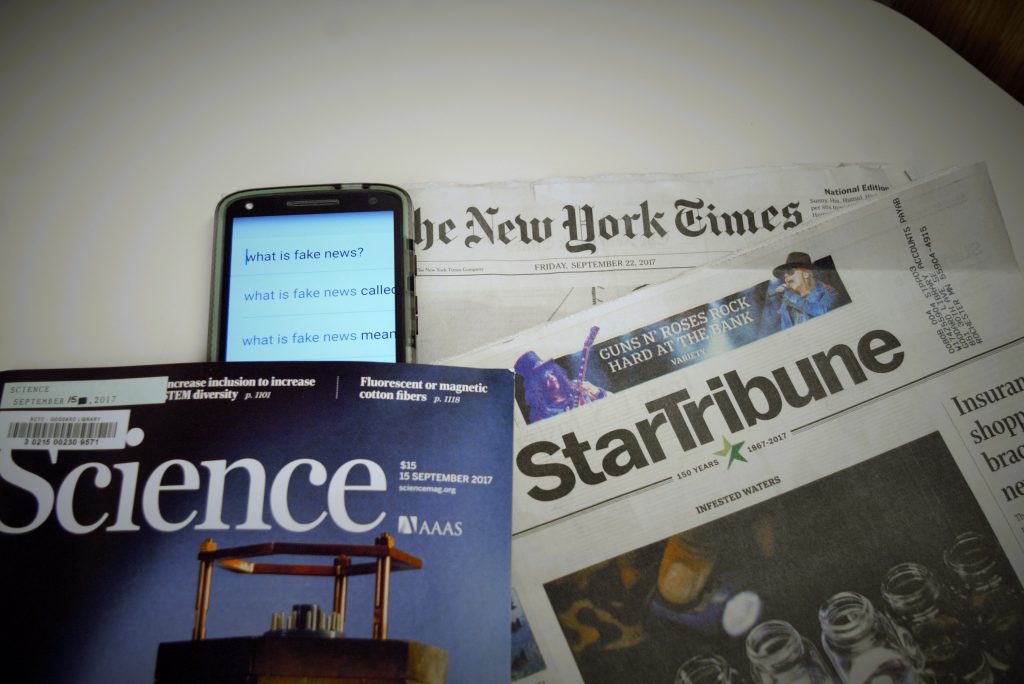By Lydia Hansen
Editor in Chief
Lydia.Hansen1961@mb.rctc.edu

Lydia Hansen
The fake news phenomenon, which has been in and out of the national spotlight these past few years, is not a laughing matter.
Earlier this semester, someone jokingly made a comment to me about fake news. Far from being offended, I responded with a laugh. But as I thought about it later, it struck me that although the joke about fake news was funny, fake news is not a joke.
In fact, fake news terrifies me. It’s frightening to see the kinds of unlikely stories people will fall for and how easily we can be misled. We may protest that we’re free and independent thinkers, but we have a dangerous tendency to allow our decision making be controlled by outside sources.
Between that and the pervasiveness of fake news and well-disguised satire, there have been many cases of people taking drastic action because of an unlikely story they heard and blindly assumed was true simply because they read it on the Internet or saw it in a magazine.
The “Pizzagate” fiasco of the 2016 presidential elections is a perfect example of how quickly fake news can spread and what it can drive people to do. In December 2016, a wide-scale Internet conspiracy theory prompted a man to fire a gun at a New York pizzeria because he thought Hillary Clinton was part of a child sex ring based there.
The rumors were, of course, false. But this individual believed what he had read was true, and he believed it enough to endanger other peoples’ lives. That’s how powerful fake news can be.
“Pizzagate” is a more extreme example of how misinformation and falsehoods can mislead people with significant consequences, but social media sites like Facebook are also rife with examples of fake news that seem far less threatening.
One rumor I’ve seen circulating recently is that putting your PIN number into an ATM backwards will call the police. This one is also false – and it should make sense, because if you happen to have the incredibly weak PIN number of 1111, how would the ATM know that your pin is backwards?
However, there is actually some truth behind this piece of fake news. According to a Forbes article from January, 2004, a man called Joseph Zingher holds patents for a SafetyPIN security system that would allow reversed pins to alert law enforcement. But although the computer code exists to make this happen, Zingher’s system isn’t being used on any ATMs today, as the rumor claims.
This is why fake news can be so dangerous. Sometimes it’s a matter of complete fiction, as “Pizzagate” was. But as the ATM example demonstrates, there is sometimes a piece of well-buried, distorted truth behind it – and that can give a falsehood credibility. Simply recognizing the threat posed by fake news doesn’t necessarily mean you’ll never fall for it.

Echo photo by Lydia Hansen
Fake news is especially dangerous because there’s often a sliver of truth embedded in the unlikely story, making the distortion seem believable.
Fact and fiction can be hard to tell apart. Take steps to avoid falling for fake news. Protect yourself from potentially harmful or foolish errors of judgment by doing some simple things whenever you hear something that sounds suspicious.
First, consider the authority of the person behind the story. We’re all familiar with the warning not to believe everything we see on the Internet. If that’s where someone is getting all their information for some wild and unlikely story from, that should raise some red flags.
I personally take less than 25 percent of what I can find on the Internet at face value. The majority of what I do believe is information I can verify through people or print sources that I know are trustworthy. Unfortunately, many people don’t do that or don’t know how, and as a result they naively assume that because they read or heard something (online or elsewhere) it must be true.
Second, if the person you’re talking to says they got their information from a reputable news source like a TV news host, broadcast network, newspaper, or other publication, don’t just take their word for it. Go check that source! Fake news can and unfortunately does happen in traditional news sources. Take the extra time to follow up with information from other sources to make sure what you’re hearing is real.
Third, recognize that fake news is sometimes merely a distortion of the facts. If you’ve ever played the game Telephone or watched a rumor travel, you know how quickly a true story can transform into something unrecognizable. Something that is fake news by the time it reaches you may have started out as a legitimate, fact-based report. Take the rumor about ATMs for example.
In order to avoid falling into the trap of fake news, start by doing your research. Find out who said what. Assess whether they are a credible, trustworthy source for that information. Think for yourself, and make up your own mind about who you will trust and why. But never let someone else do your thinking for you.
Fake news is not a joke, but if you fall for it, the joke is on you.
